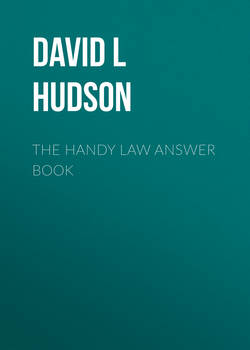Читать книгу The Handy Law Answer Book - David L Hudson - Страница 110
На сайте Литреса книга снята с продажи.
SECOND AMENDMENT What makes the Second Amendment controversial?
ОглавлениеThere are two very different interpretations of the Second Amendment, which provides: “A well regulated Militia, being necessary to the security of a free State, the right of the people to keep and bear Arms, shall not be infringed.” The Second Amendment consists of two clauses—the prefatory clause speaking of a “well-regulated militia” and an operative clause speaking of the “the right of the people to keep and bear arms.”
One interpretation of the Second Amendment focuses on the militia clause, emphasizing that the amendment was only designed to protect a collective right to bear arms through a militia. This collective-rights interpretation does not believe that the amendment was designed to give individuals a constitutional right to bear arms. The other interpretation of the Second Amendment—the individual-rights model—believes that the amendment gives individuals the right to bear arms.
LegalSpeak: Tinker v. Des Moines Independent Community School District (1969)
Justice Abe Fortas (majority): “It can hardly be argued that either students or teachers shed their constitutional rights to freedom of speech or expression at the schoolhouse gate…. The District Court concluded that the action of the school authorities was reasonable because it was based upon their fear of a disturbance from the wearing of the armbands. But, in our system, undifferentiated fear or apprehension of disturbance is not enough to overcome the right to freedom of expression. Any departure from absolute regimentation may cause trouble. Any variation from the majority’s opinion may inspire fear. Any word spoken, in class, in the lunchroom, or on the campus, that deviates from the views of another person may start an argument or cause a disturbance. But our Constitution says we must take this risk, and our history says that it is this sort of hazardous freedom—this kind of openness—that is the basis of our national strength and of the independence and vigor of Americans who grow up and live in this relatively permissive, often disputatious, society.
“In order for the State in the person of school officials to justify prohibition of a particular expression of opinion, it must be able to show that its action was caused by something more than a mere desire to avoid the discomfort and unpleasantness that always accompany an unpopular viewpoint. Certainly where there is no finding and no showing that engaging in the forbidden conduct would ‘materially and substantially interfere with the requirements of appropriate discipline in the operation of the school,’ the prohibition cannot be sustained.”
Justice Hugo Black (dissenting): “Even a casual reading of the record shows that this armband did divert students’ minds from their regular lessons, and that talk, comments, etc., made John Tinker ‘self-conscious’ in attending school with his armband. While the absence of obscene remarks or boisterous and loud disorder perhaps justifies the Court’s statement that the few armband students did not actually ‘disrupt’ the classwork, I think the record overwhelmingly shows that the armbands did exactly what the elected school officials and principals foresaw they would, that is, took the students’ minds off their classwork and diverted them to thoughts about the highly emotional subject of the Vietnam war. And I repeat that if the time has come when pupils of state-supported schools, kindergartens, grammar schools, or high schools, can defy and flout orders of school officials to keep their minds on their own schoolwork, it is the beginning of a new revolutionary era of permissiveness in this country fostered by the judiciary. The next logical step, it appears to me, would be to hold unconstitutional laws that bar pupils under 21 or 18 from voting, or from being elected members of the boards of education.”
LegalSpeak: District of Columbia v. Heller (2008)
Justice Antonin Scalia (majority): “Putting all of these textual elements together, we find that they guarantee the individual right to possess and carry weapons in case of confrontation. This meaning is strongly confirmed by the historical background of the Second Amendment. We look to this because it has always been widely understood that the Second Amendment, like the First and Fourth Amendments, codified a pre-existing right. The very text of the Second Amendment implicitly recognizes the pre-existence of the right and declares only that it ‘shall not be infringed.’”
Justice John Paul Stevens (dissenting): “The Second Amendment was adopted to protect the right of the people of each of the several States to maintain a well-regulated militia. It was a response to concerns raised during the ratification of the Constitution that the power of Congress to disarm the state militias and create a national standing army posed an intolerable threat to the sovereignty of the several States. Neither the text of the Amendment nor the arguments advanced by its proponents evidenced the slightest interest in limiting any legislature’s authority to regulate private civilian uses of firearms. Specifically, there is no indication that the Framers of the Amendment intended to enshrine the common-law right of self-defense in the Constitution.”
